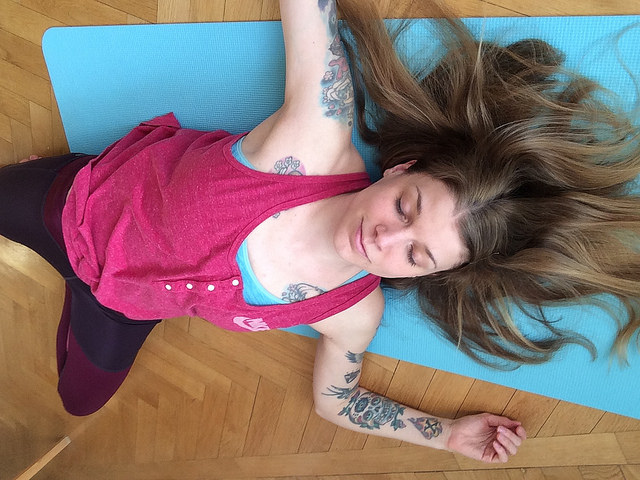
It wasn’t until I went through my 200-hour teacher training last fall that I realized how much goes into leading a yoga class.
I quickly learned the extraordinary amount of courage, creativity and compassion yoga teachers possess.
The first time I heard myself speak in front of students—when I really listened—I couldn’t believe that the sound coming out of my mouth was my own voice. “That’s what I sound like? My God!”
And let’s be clear, there is an enormous difference between knowing something—knowing it in the tissue of your body, in your DNA—and verbalizing it. Despite having been an avid yogi for years and having done certain sequences way more than a dozen times, I could barely choke out a simple sun salutation for the first few weeks of training. I’d roll out my mat and do the sequence sans instruction, but when it came time to lead others through it, I couldn’t even tell left from right. Go figure.
Aside from not being able to even vocalize what I wanted my students to do, there were times when the English language completely failed me. My favorite might just be: “Hi, my Jenna is name and I’ll be leading you through the next practice of hour.” And “Feel the lungs in your air”—I can’t tell you how many times those words have left this mouth.
The funny thing? I didn’t even know what I was saying until my mentor told me after class. I completely blacked out and didn’t remember a single word I’d said. We’ve all been there a few times, right?
As a new teacher, it’s the easiest thing in the world to get trapped in your mind. On top of telling a group of real, live humans how to move, I’m also in charge of their breath, safety and overall experience in class. Don’t forget about adjustments, assists, sequencing, lights, music, heat, timing and pace.
I simultaneously need to be aware of the yogi in the back corner who is hyper-extending her knee, the athlete in the middle with the tight hamstrings and the rest of the bodies before me. Yoga teacher? I might as well be labeled a professional multi-tasker. It feels like the weight of the world is on my shoulders when I’m up in front of the class, and one mistake can send me spiraling into darkness.
But then I catch myself and pull myself out of my head space.
This isn’t the Jenna show; this is about my students and I’m here to serve them. Once I remember the experience isn’t about me, I’m not as scared. My nerves start to calm and I come back to my intention of kindness and service. I know if I’m all whacked out, then I’m sending those vibrations out into the room. And that’s not the experience I want to create.
When the focus shifts back to the students everything feels right and and I fall into my flow. What I put out into the room is coming from my heart, not my head. I listen. I observe. I assist. I adjust. I am fully present, not dwelling on what happened before in the warrior series or worrying about what I’ll say during surrender.
That’s where the magic happens and I am reminded why I started teaching in the first place: to share the gift of yoga—a practice that rocked my world—with others.
My advice to you? Remember why you chose to be a teacher and use that as a flotation device when you feel like you’re about to go under. It will bring you back above the surface each and every time.
And don’t forget to breathe. That always helps.
What are your tried-and-true ways of talking yourself down from the ledge or calming your nerves while teaching? Share your two cents in the comment section below.
Author: Jenna Dailey
Apprentice Editor: Julie Barr; Editor: Nicole Cameron
Image: Helen Alfvegren/Flickr






Read 9 comments and reply